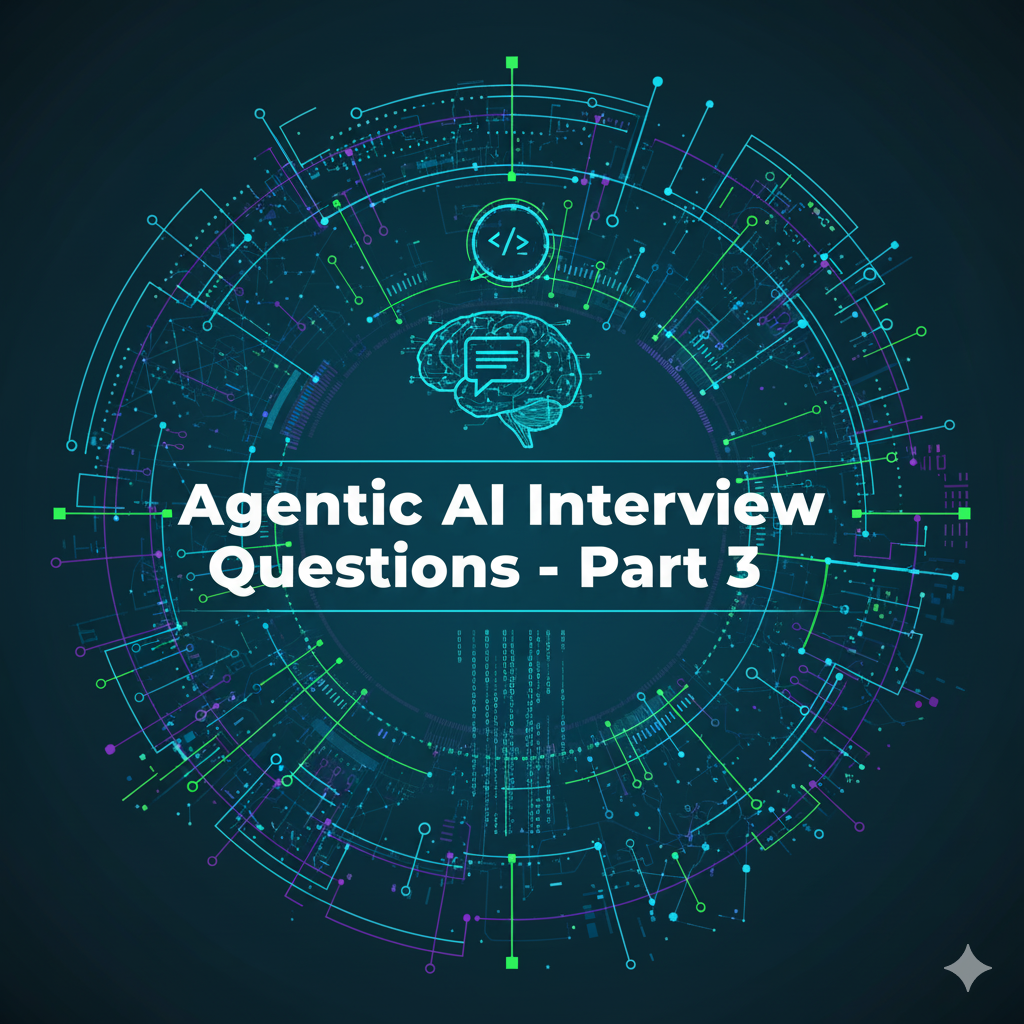Welcome to Part 3 of our Agentic AI Interview Questions Series, where we go beyond theory and dive into how agentic AI systems are built, deployed, and aligned at scale. This installment focuses on advanced topics that appear frequently in senior-level interviews for AI research, applied AI, and autonomous system engineering roles.

Let’s explore the final 10 high-impact interview questions that test your understanding of persistent memory, system testing, scalability, and responsible agent behavior.
26. What is persistent memory in agentic systems and why is it needed?
Persistent memory allows agents to remember facts, preferences, and outcomes across sessions or even device restarts.
Key reasons:
- Enables continuity in long-running or recurring tasks
- Stores user preferences and personalization
- Prevents redundant tool calls or repeated questions
- Supports reflection and long-term learning
Common implementations:
- Vector databases (e.g., Chroma, Weaviate) for semantic search
- Key-value stores (e.g., Redis, DynamoDB) for structured storage
- Filesystem/JSON memory in simple agents
Agents with persistent memory feel more intelligent, personalized, and context-aware—crucial for enterprise or user-facing applications.
27. How can agentic workflows be orchestrated at scale?
Agent orchestration frameworks help manage multiple agents, tools, and states across workflows.
Popular tools:
- LangGraph: Declarative state machines for LLM agents
- CrewAI: Role-based agent teamwork
- Autogen (Microsoft): Configurable multi-agent chat loops
- LangChain Expression Language (LCEL): Pipeline definitions for agent steps
Features:
- Dependency resolution between agents
- Parallelism and task scheduling
- Retry/error recovery
- Step logging and observability
These tools are essential when moving from prototype agents to scalable pipelines in production.
28. How are agents tested and validated in production systems?
Testing autonomous agents is challenging due to:
- Non-deterministic outputs
- Dynamic tools or APIs
- Multiple acceptable paths to a goal
Approaches include:
- Unit tests: For prompt templates, tool interfaces, fallback logic
- Simulated environments: For running agents with mock APIs
- Golden path testing: Provide fixed inputs and assert outputs
- Behavioral monitoring: Alert on deviations, timeouts, loops
Testing is vital to catch silent failures, security issues (e.g., prompt injection), or tool misuse before real-world deployment.
29. What is agent alignment and why is it important?
Agent alignment ensures that the agent’s behavior matches user intent, ethical boundaries, and organizational objectives.
Misaligned agents may:
- Take unintended actions
- Misinterpret ambiguous instructions
- Hallucinate results that seem plausible but are wrong
Alignment techniques:
- Clarification loops (“Do you want me to confirm before booking?”)
- Instruction tuning with safety prompts
- Guardrails to filter unsafe or biased responses
- User feedback mechanisms for continual learning
Alignment is critical in customer-facing, safety-critical, or high-trust domains like healthcare, finance, and education.
30. What are agent simulators and how are they used for testing?
Agent simulators are sandbox environments that mimic real-world tasks, APIs, or user interactions. They allow:
- Safe experimentation with agent behavior
- Evaluation under controlled scenarios
- Debugging of planning and tool use logic
Examples:
- Simulated e-commerce platforms
- Document retrieval mock APIs
- Virtual customer support chats
- Research environments (e.g., WebArena, BabyAGI-sim)
Simulators help stress-test agents before they go live, especially in continuous loops or sensitive pipelines.
31. What are human-in-the-loop (HITL) systems in agentic AI?
Human-in-the-loop systems include humans as validators or overseers of agent decisions.
Why it matters:
- Prevents catastrophic errors
- Adds reliability in uncertain decisions
- Helps train agents via feedback and preference modeling
Modes of HITL:
- Pre-action confirmation (“Shall I send this email?”)
- Post-hoc approval (Review generated content)
- Ongoing override (Interrupt agents mid-loop)
HITL strikes a balance between autonomy and control, especially in regulated or mission-critical applications.
32. How do you prevent infinite loops in autonomous agents?
Looping occurs when agents repeatedly re-evaluate or fail to exit their planning loop.
Prevention strategies:
- Step limits: Max iteration caps
- Goal checks: If goal achieved, stop
- Watchdog agents: Meta-agent that monitors behavior
- Timeouts: Per tool call and overall run
- State diff checks: Ensure agent is progressing (not repeating same step)
Loop detection is critical to ensure reliability and cost-efficiency in production agents.
33. What is preference modeling in agentic systems?
Preference modeling means encoding user-specific priorities, styles, and goals into the agent’s reasoning process.
Examples:
- Preferring concise summaries over verbose explanations
- Avoiding certain brands or providers in recommendations
- Personal tone/style in writing agents
Methods:
- Prompt injections based on user profiles
- Fine-tuned models per user segment
- Memory lookups with preferences
Preference modeling creates personalized, adaptive agents that feel more human-aware and helpful.
34. What’s the role of vector stores in long-term agent memory?
Vector stores support semantic memory by storing and retrieving relevant text chunks based on similarity.
Use cases:
- Long-term knowledge base
- Conversation history
- Past action logs or observations
Popular tools: FAISS, Chroma, Weaviate, Pinecone
Workflow:
- Agent encodes query
- Vector search returns top-k relevant items
- Agent incorporates retrieved memory into context window
This enables contextually rich, memory-efficient agents, especially when token limits are a constraint.
35. How does prompt design differ for agentic systems compared to standard LLMs?
Prompt design in agentic systems must account for multi-step reasoning, tool invocation, and context continuity—far beyond single-turn interactions in standard LLM applications.
Key differences:
- Structured formats like
Thought → Action → Observation → Next Thoughtfor reasoning loops (ReAct or scratchpad style) - Instruction layering: Including behavior rules (e.g., “Use tools only when needed”) + task goal + agent role
- Memory conditioning: Injecting past context or persistent facts dynamically
- Tool syntax templating: Ensuring output is parseable by the agent controller
Example prompt for an agent:
You are a research assistant. Your task is to search for current stock prices and summarize key insights.
Thought: I need the stock price of Tesla.
Action: search_tool["Tesla stock price today"]
Observation: Tesla stock is at $245.
Thought: Now I can summarize the insight.
Response: Tesla stock is currently trading at $245.
Effective prompt engineering ensures predictability, modularity, and safety in agentic pipelines.
Conclusion
In Part 3 of our Agentic AI Interview Questions series, we explored real-world deployment strategies for autonomous agents—from persistent memory and orchestration to evaluation, safety, and preference modeling. These topics are key to building robust, trustworthy, and scalable AI agents ready for enterprise use.
Stay tuned for Part 4, where we’ll dive into:
- Multi-agent emergent behavior
- Memory compression and summarization
- Auto-reflection with external logs
- Agent hallucination debugging
- Best practices for prompt design in agents
Related Read
Agentic AI Interview Questions – Part 2
